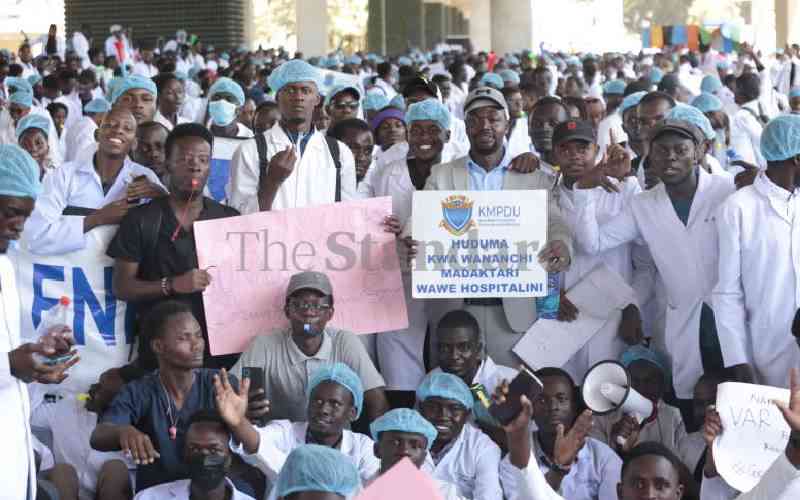As Covid-19 continues to disrupt countries around the world, food security and livelihoods are at risk particularly for the most vulnerable populations. Dairy presents a unique opportunity to address some of the most detrimental effects of the pandemic while putting the systems on a path toward more resilient, sustainable and inclusive growth. The dairy sector in Kenya provides vital nutrition for both rural households and urban consumers and employs thousands of women and men along the value chain.
In Laikipia, a county with a population of over 55,000 heads of dairy cattle, the estimated daily milk production is over 100,000 litres. The county milk consumption index is 2.2 which is quite above the national average of 2.0. It is a major employer, especially in the rural and peri-urban areas. Many homesteads in Igwamiti, Marmanet, Githiga, Olmoran, Rumuruti, Salama, Sosian, Gorbit, Tigithi, and Umande wards keep dairy cows, hence creating employment opportunities for many smallholder farmers and their families.
The dairy value chain is a major contributor to the county gross domestic product. About 90 million Kenya shillings is paid directly to the farmers from the formal dairy processors to the farmers. A similar amount is paid to the primary producers by domestic consumers in the informal sector. This is a value chain whose effect cannot be under-estimated.
In Kenya, dairy is a relatively structured agricultural value chain in Kenya, with farmers primarily supplying to large dairy processors like Brookside and New KCC who make up 80 per cent of the dairy market either directly or via cooperatives and aggregators. For dairy farmers, the arrival of Covid-19 has affected both production and sales. First, animal feeds are becoming difficult to procure and more expensive as people buy up maize for their own consumption. Also, milk is a perishable good but farmers able to continue producing milk find their options for transport to their cooperative or aggregation centre constrained. Uninterrupted transport is critical for their income to be secured but most farmers do not have on-site cooling facilities.
The dairy sector has seen further disruption as a result of Covid-19. Some of the cases of disruption include a shift away from the wholesale foodservice markets since hotels, restaurants and schools have closed. Some milk processors are also reporting difficulty in finding drivers to transport milk from farms due to fears of contracting the virus. Consumption and consumer purchasing power have also reduced due to massive job losses in the informal sector. Many processors are just stockpiling their products and struggling to pay their raw milk suppliers.
There is a major concern of the spreading coronavirus disease especially to the actors in the production and raw milk production nodes. The spread of coronavirus could manifest itself in various ways in the dairy chain.
The main mode of raw milk transportation method from the farms to the bulking and chilling plants is by motor bike riders (boda boda transport). Most of the actors are youthful men who collect milk from farm to farm or collection centres in designated areas. There are some who interact with over 200 farmers and staff at cooling centres. They also run errands for farmers like ferrying dairy meal, fertilizers or other farming inputs after ferrying the milk to the plants.
Some of them even hawk milk directly to consumers in trading centres or traders in milk bars. There has not been a formal session of building capacities on how those riders could be tested, and trained on how to protect themselves and their clients during their daily routine activities. They have no access to certified alcohol-based government donated sanitisers and face mask. Testing facilities are not locally available. It’s not possible to wash hands with running water under field conditions. Sanitisers are quite essential.
Most actors in the dairy at the production level are elderly farmers with an average age of 60 years. Their body immunity is low. Some have diseases like diabetes, high blood pressure, and other diseases associated with old age.
The new normal presented by Covid-19 means dairy cooperatives are less likely to operate at full capacity due to the need to implement social distancing measures within their facilities. Demand for milk is expected to decline as families' purchasing power declines and they prioritise buying staples and non-perishables. Large institutional buyers such as hotels and schools remain closed.
The large processors have slightly increased prices to encourage continued production. However, this will be increasingly difficult if the decline in consumer demand continues. If large processors stop buying milk, dairy farmers will have no way to sell their main agricultural output, causing declines in income and savings. This could lead farmers to sell their cows for short-term income, endangering their long-term income potential when the market stabilizes.
The relevant government actors need to address and formulate the best ways on how to protect and prevent the spread of Covid-19 in the county through the dairy value chain. Daily interaction of the farmers and the youthful riders could be disastrous unless good measures such as targeted awareness on Covid-19 precautionary measures and provision of face masks are put in place.
John Ndegwa Wakirira works with Laikipia Dairy Platform and Idah Kinya, Consumer Unity and Trust Society.
 The Standard Group Plc is a
multi-media organization with investments in media platforms spanning newspaper
print operations, television, radio broadcasting, digital and online services. The
Standard Group is recognized as a leading multi-media house in Kenya with a key
influence in matters of national and international interest.
The Standard Group Plc is a
multi-media organization with investments in media platforms spanning newspaper
print operations, television, radio broadcasting, digital and online services. The
Standard Group is recognized as a leading multi-media house in Kenya with a key
influence in matters of national and international interest.
 The Standard Group Plc is a
multi-media organization with investments in media platforms spanning newspaper
print operations, television, radio broadcasting, digital and online services. The
Standard Group is recognized as a leading multi-media house in Kenya with a key
influence in matters of national and international interest.
The Standard Group Plc is a
multi-media organization with investments in media platforms spanning newspaper
print operations, television, radio broadcasting, digital and online services. The
Standard Group is recognized as a leading multi-media house in Kenya with a key
influence in matters of national and international interest.









